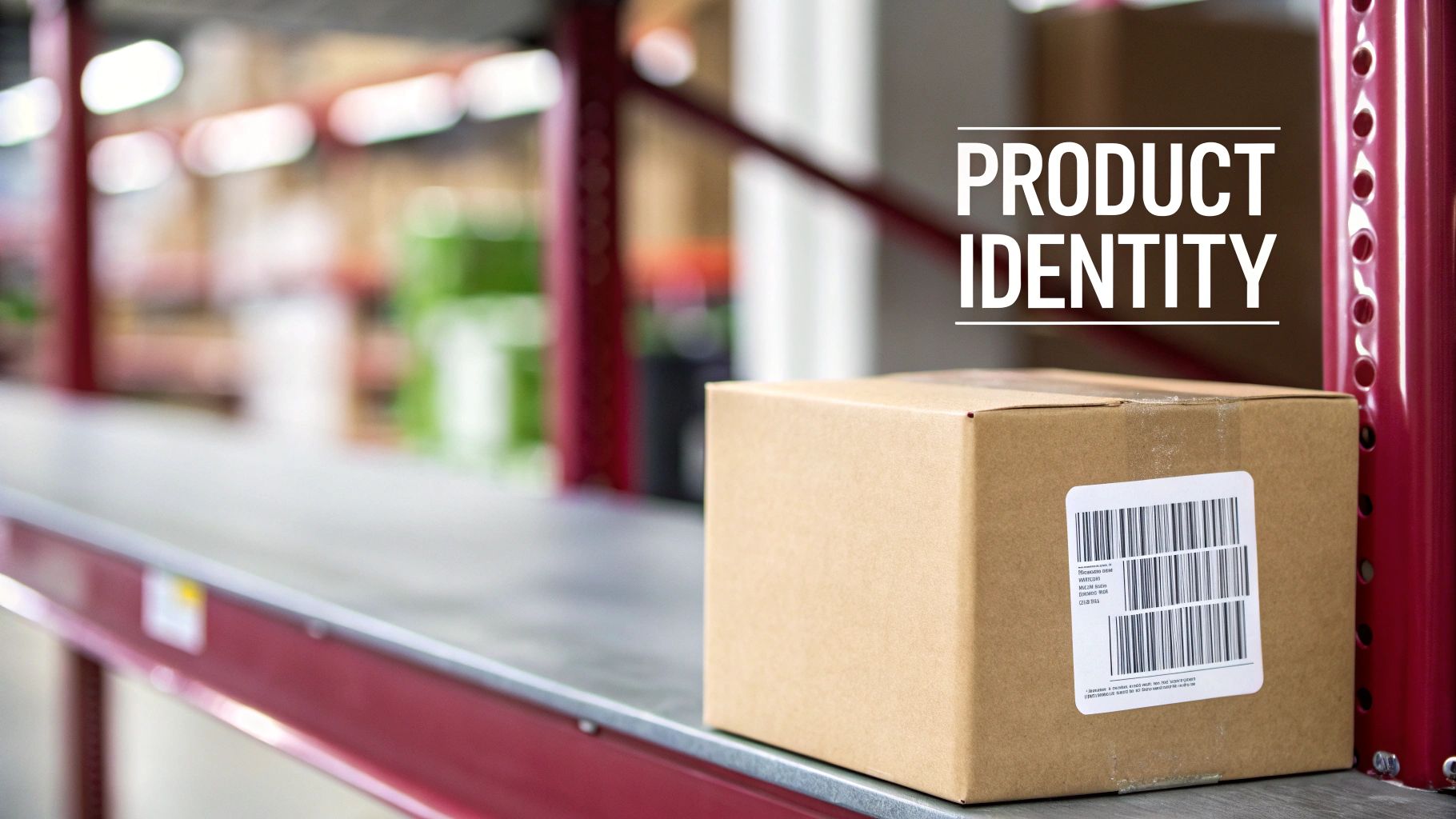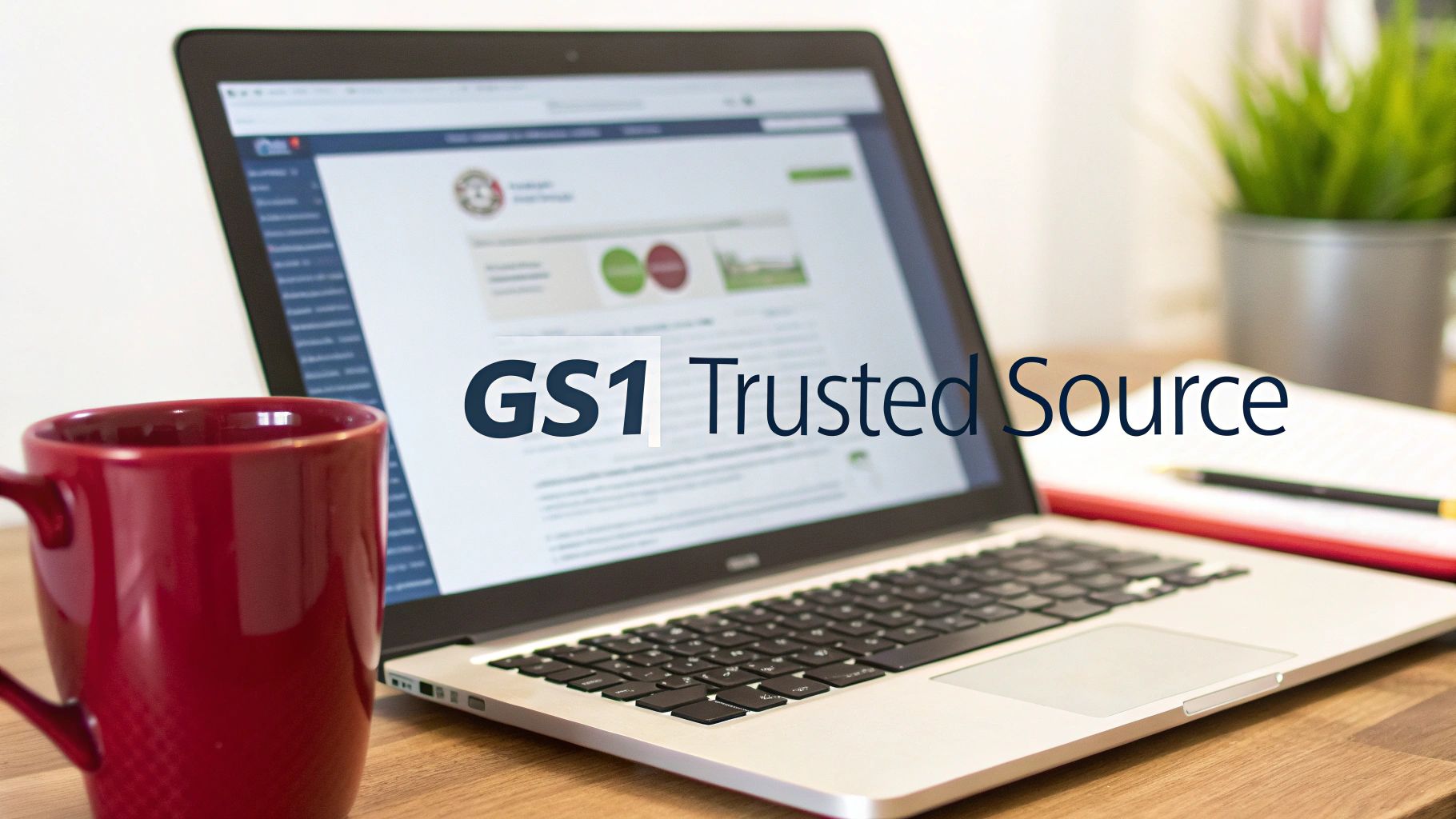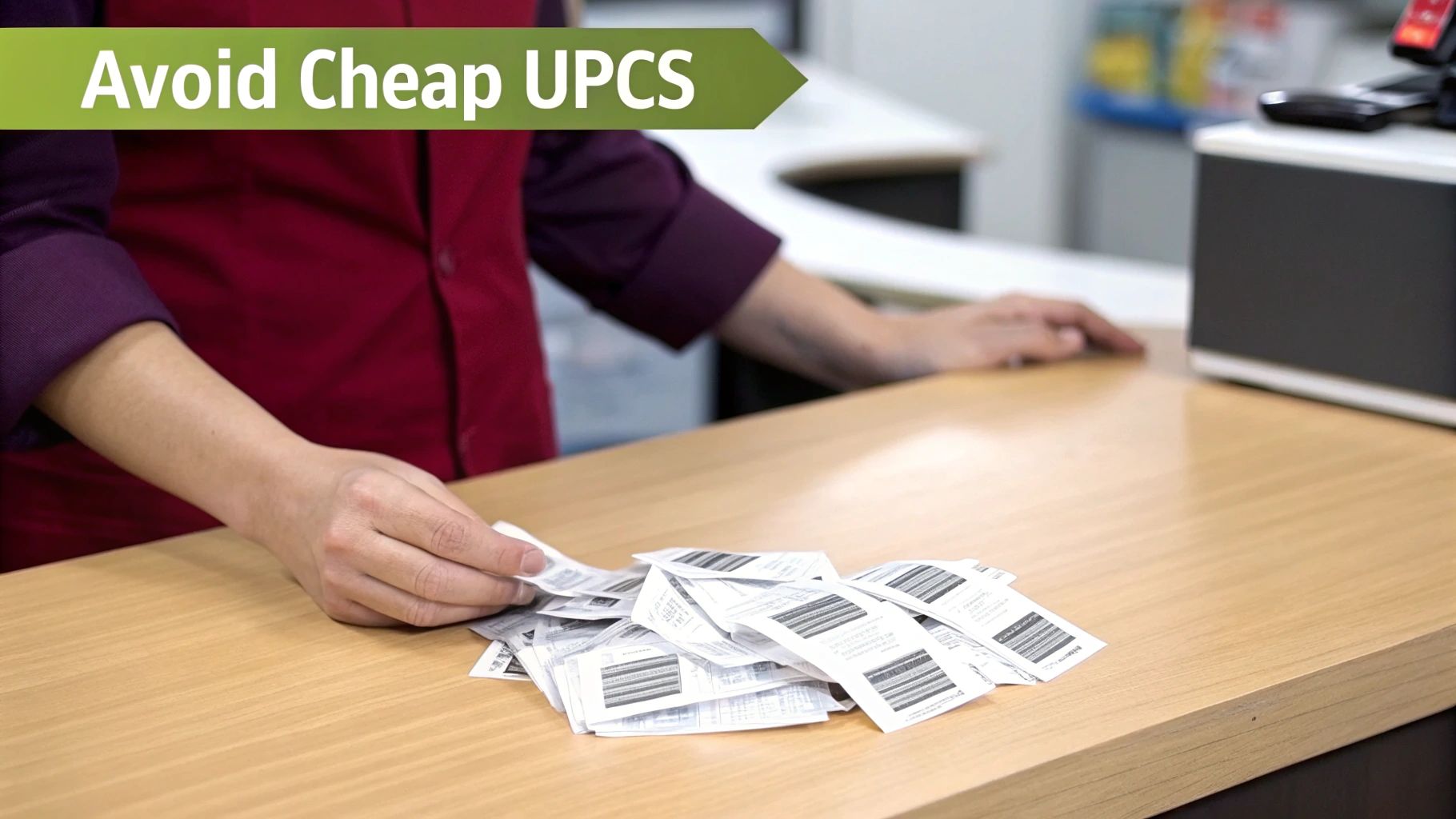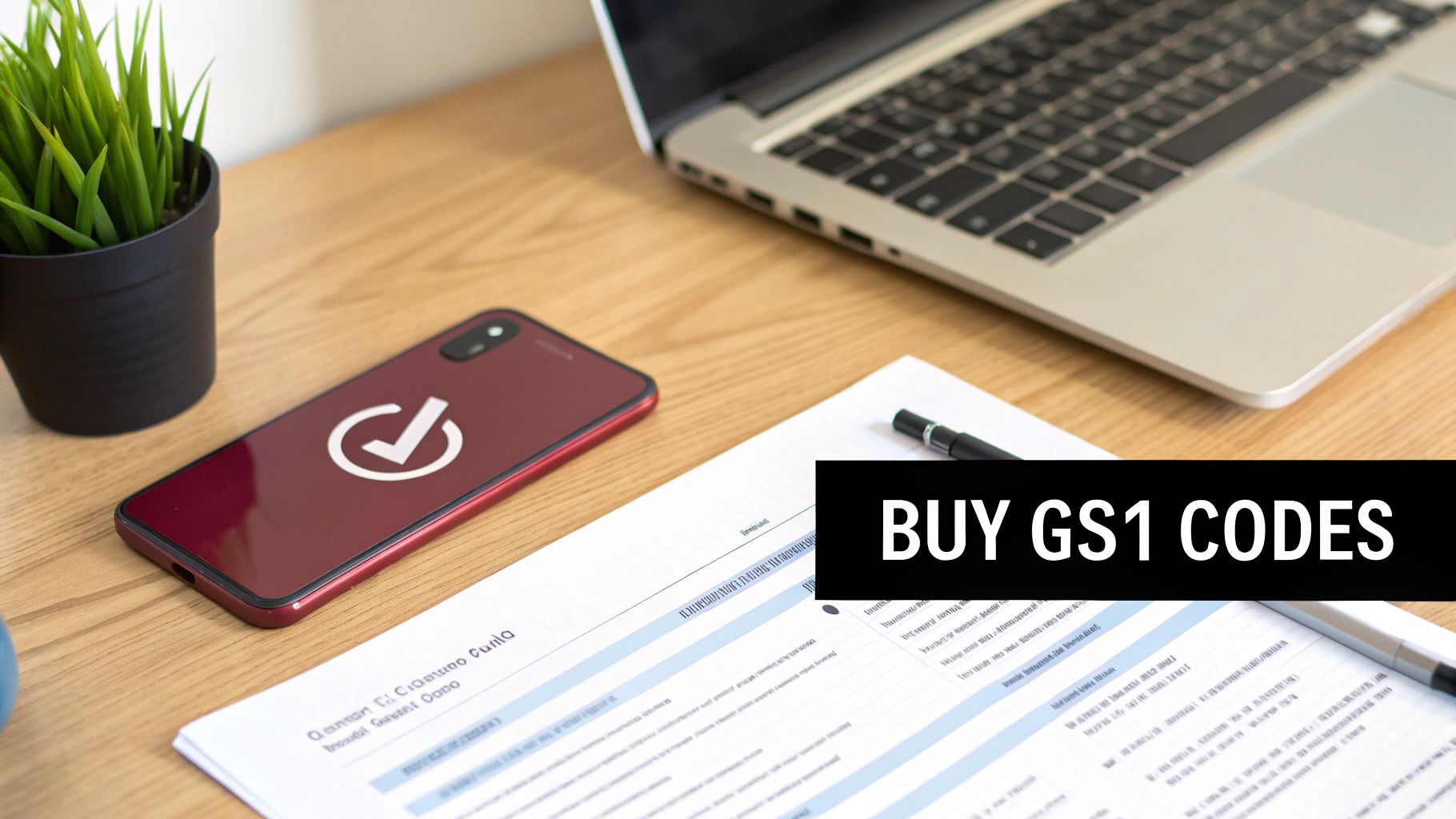When you're ready to buy UPC codes for your Amazon products, the process seems simple on the surface. You need a valid Global Trade Item Number (GTIN), and for Amazon, the only truly trusted source is GS1.
You'll find plenty of cheaper resellers out there. But let's be direct: using their codes is a massive gamble. It's a shortcut that can get your listings suppressed or, even worse, your entire account suspended. It's just not worth the risk.
Why Amazon Is So Strict About UPC Codes

If you're launching a new product, you’ll learn fast that a UPC code is the foundation of your listing. Think of it as your product's social security number. It's the unique identifier Amazon uses to generate an ASIN (Amazon Standard Identification Number), which becomes your product’s official ID in its huge catalog.
A valid UPC makes sure your item isn't mixed up with something else. It helps Amazon track your inventory from the second it hits the warehouse to the moment it lands on a customer's doorstep. It also protects your brand from hijackers trying to create duplicate or counterfeit listings.
Getting this right from the start with a legitimate GS1 code builds immediate trust with Amazon’s system. Trust me, it prevents some major headaches down the road.
The Foundation of Your Amazon Listing
This isn't just about ticking a compliance box; it's about establishing control and legitimacy. When you register a UPC through GS1, that code is directly linked to your company's name in a global database. This creates a clear, verifiable chain of ownership that Amazon's algorithm respects.
This is a vital piece of the puzzle for securing your brand and often a prerequisite for accessing advanced tools. To see how this plays into the bigger picture of brand defense, you should check out our deep dive on Amazon brand gating.
Key Takeaway: A valid UPC is more than a barcode. It’s the unique identifier that connects your physical product to its digital listing, guaranteeing accurate inventory tracking and shielding your brand from identity theft on the platform.
As of 2025, Amazon requires that every new product listing includes a unique GTIN. They don't just prefer UPCs from GS1; they practically mandate it to ensure authenticity. Using a resold code is a direct path to rejection.
This reliance on unique, GS1-verified UPCs is essential for managing a platform with over 9.7 million registered sellers globally. It’s how they maintain order.
Understanding these strict UPC rules is especially important if you're building a broader e-commerce strategy, like connecting Shopify to Amazon to diversify your sales channels. Nailing your product identification is always the first step in a successful multi-channel plan.
GS1: The Only Source Amazon Actually Trusts

Let's get straight to it. When you're sourcing UPC codes for your Amazon products, you'll find dozens of websites promising cheap codes for a few bucks. It looks like a great way to save money, but it's a trap I've seen countless sellers fall into.
There is only one source Amazon officially recognizes and trusts without question: GS1.
GS1 is the global non-profit that develops and maintains the supply chain standards used worldwide, including the barcodes you see on almost every product. Think of them as the official global registry for product identifiers. When you get a code from GS1, you’re not just buying a number; you're licensing a unique identifier that is registered to your company in a global database.
This is the single most important detail Amazon’s system checks. An official GS1 code proves you are the legitimate owner of that product. Using anything else is like showing up with a fake ID. It might work for a bit, but you're setting yourself up for serious trouble.
Why a GS1 Company Prefix Matters So Much
When you register with GS1, you’ll be assigned a GS1 Company Prefix. This unique string of numbers becomes the foundation of all your product UPCs, digitally linking every single item you sell directly back to your brand.
For anyone serious about building a private label brand on Amazon, this prefix is essential.
- Brand Legitimacy: It’s definitive proof to Amazon that you own the products you're listing.
- Hijacker Protection: It makes it much harder for bad actors to create counterfeit listings of your products.
- Future-Proofing: It sets you up for expansion into major retail stores like Target or Walmart, which also require GS1 codes.
Amazon's reliance on these codes isn't unique. GS1-issued UPCs are the worldwide standard for identifying products everywhere, from physical store shelves to every major e-commerce platform. As more sellers get burned by cheap, recycled codes, getting a legitimate one from GS1 has become a fundamental investment for any brand that wants to last.
Single GTIN vs. Company Prefix: Which Is Right for You?
GS1 offers two main paths for sellers. Your choice really boils down to your business goals and where you see your brand in a year or two. Before we get into it, a quick but important tip:
Pro Tip: Never use the same UPC for different product variations. A red t-shirt in size medium needs a different UPC than the same red shirt in size large. Every unique, sellable item must have its own distinct GTIN.
Let's break down the options.
The Single GS1 US GTIN
This is the perfect entry point if you’re just testing the waters or launching your very first product. It’s simple and straightforward.
- Cost: A one-time fee of $30 per code.
- Best for: Sellers launching a single product or a very small handful of items with no immediate plans to expand their catalog.
- Limitation: The company name associated with the code isn't customizable; it's simply registered to you as an individual or your business without the branded prefix.
The GS1 Company Prefix
This is the standard for any business with a product catalog or clear plans for growth. It’s the professional choice.
- Cost: Starts at $250 for 10 UPCs, which includes an annual renewal fee. The more codes you license, the lower the per-code cost becomes.
- Best for: Private label brands, businesses with multiple products or variations, or any seller planning to launch more products in the future.
- Benefit: All your codes will start with your unique company prefix, cementing your brand’s identity in the GS1 global database.
To help you decide, here’s a quick comparison of the two GS1 options available to you as an Amazon seller:
GS1 UPC Options for Amazon Sellers
| Feature | Single GS1 US GTIN | GS1 Company Prefix |
|---|---|---|
| Best For | Testing the market with 1-9 products | Serious brands with 10+ products or plans for future growth |
| Cost Structure | $30 one-time fee per GTIN | Starts at $250 initial fee + annual renewal fee |
| Brand Identification | Registered to your name/company, but no unique company prefix | All your UPCs start with your unique prefix, identifying your brand |
| Scalability | Limited; you must buy new individual GTINs for each new product | Highly scalable; easily generate new UPCs as your product line expands |
| Retail Readiness | May not be accepted by all major retailers | The standard requirement for most major retailers like Walmart & Target |
Ultimately, choosing the right path is a critical first step, long before you even think about how to list products on Amazon. Viewing the GS1 fee as a foundational investment rather than just another expense is the first step toward building a resilient and scalable brand.
The Hidden Dangers of Cheap UPC Resellers

It’s incredibly tempting. You do a quick search for "buy UPC codes" and see sites offering dozens of them for just a few bucks. For new sellers trying to keep costs down, it looks like a no-brainer.
But I’ve seen this shortcut end in absolute disaster for too many entrepreneurs. This is one corner you just can’t afford to cut.
Those cheap codes are a ticking time bomb. They aren't new. They're almost always "recycled" UPCs originally assigned to other companies, sometimes businesses that folded decades ago. The reseller doesn’t have any legal right to them, but that doesn't stop them from selling them.
The catch is that the code is still officially tied to the original company's name in the GS1 global database. And that’s where the trouble starts.
The Brand Mismatch Nightmare
When you create a new product listing on Amazon, you’ll enter your brand name and the UPC you bought. Amazon’s system then does a quick check against the GS1 database.
It’s looking to see if the brand name you entered matches the brand name registered to that UPC. With a reseller code, it never will. This mismatch triggers a few different nightmare scenarios.
- Immediate Listing Rejection: You might get lucky, and Amazon will simply block you from creating the listing right away, showing an error message that the UPC doesn't match the brand.
- Delayed Listing Suppression: This one is far worse. Your listing gets approved, you ship inventory to FBA, and your product starts selling. Then, months later, an Amazon audit flags the mismatch, and your listing is suddenly suppressed without warning.
- Stranded Inventory: Once your listing is suppressed, all the inventory you have at FBA warehouses becomes stranded. You can’t sell it, but you’re still paying storage fees on it while you scramble to fix a problem that was completely avoidable.
Imagine your best-selling product vanishing from search results right before Q4. Your sales velocity tanks, your Best Seller Rank plummets, and your inventory is held hostage. This isn't a hypothetical situation; it happens every day. The few dollars you thought you were saving can end up costing you thousands in lost revenue and logistical chaos.
A Cautionary Tale: A client of mine bought 100 UPCs from a popular reseller for about $50. Six months after a successful launch, three of their top-performing ASINs were suppressed for UPC conflicts. It took over four weeks of back-and-forth with Seller Support to resolve, resulting in nearly $15,000 in lost sales.
The Long-Term Account Health Risk
Beyond the immediate listing headaches, using illegitimate UPCs puts your entire seller account in jeopardy. Amazon views this as an attempt to get around their policies, and they don't take it lightly.
Repeated offenses can lead to account warnings or even a full-blown suspension. And if you end up in that spot, getting your account back online is another level of stress.
Buying UPC codes from a reseller is a gamble where the odds are completely stacked against you. It's an unforced error that can undermine all the hard work you’ve put into building your brand.
A Practical Walkthrough for Buying GS1 Codes

Alright, time to get this done. Buying codes directly from GS1 US can feel a bit corporate or even intimidating if you've never done it, but it's more straightforward than it looks. Think of this as getting the official birth certificate for your product. It's a necessary step to sell on Amazon properly.
The screenshot above shows you where you'll be starting. This is the only source Amazon truly trusts, so bookmark it.
First, Figure Out How Many Codes You Actually Need
Before you even click "buy," you need to plan. This is where I see a lot of new sellers trip up. They underestimate their needs and have to go back to GS1 a few months later, which costs more time and money.
Here's the golden rule: every single unique variation of your product needs its own unique UPC. This isn’t just about different products. It’s for every possible version a customer can add to their cart.
Let's break it down with a real-world example:
- Different Sizes: You're selling t-shirts in Small, Medium, and Large. That’s three separate UPCs.
- Different Colors: You have a blue widget and a red widget. That’s two UPCs.
- Different Pack Counts: Selling a single unit and a 3-pack bundle of the same item? Yep, you'll need two different UPCs.
Get out a spreadsheet and map out your entire product line. Don’t just think about what you have now; consider the variations you're planning to launch in the next year. It's always better to have a few extra codes ready than to run out. This kind of planning is fundamental if you're serious about learning how to start an ecommerce business on Amazon.
Choose Your Path: Single GTIN or a Company Prefix
Once you have your number, GS1 gives you two main options. We've touched on this, but let's talk about the practical side of the decision.
If you did the math and you absolutely, positively only need nine or fewer codes, then the Single GS1 US GTIN is your move. It’s a one-time fee of $30 per code, and you're done. No annual fees, no strings attached. This is perfect for sellers who are just testing a single product with no planned variations.
But, if you need 10 or more codes (or even think you might in the near future), you need to license a GS1 Company Prefix. This is the standard for any brand that plans to grow. The initial cost is higher, starting at $250 for 10 codes, and you'll have an annual renewal fee. But what you're really buying is an official block of barcodes that are registered globally to your brand name.
Seller Insight: My advice? If you're even slightly confident you'll launch more products, just go for the Company Prefix. It establishes your brand in the global database from day one and is way more cost-effective in the long run than buying single GTINs over and over again. You'll thank yourself later.
Getting Your Information Ready
The application itself is just a form, but having your information ready will make it a five-minute job. GS1 needs some basic information to register your company.
Here’s what you should have handy:
- Company Name and Address: Make sure this matches your Amazon seller account information exactly. Amazon's system looks for consistency.
- Contact Information: A reliable point of contact for your business.
- Payment Method: They take all major credit cards.
After you complete the purchase, GS1 will email you a certificate of ownership along with your new UPC numbers. Save that certificate somewhere safe. It's your official proof if Amazon's support team ever gives you trouble over your barcodes.
And that's it! You're now equipped with 100% legitimate, verifiable UPCs, ready to create your Amazon listings with complete confidence.
Common UPC Mistakes Amazon Sellers Make
Having a legitimate GS1 code feels like a huge win, but honestly, it’s just the starting line. I’ve seen so many sellers invest in proper UPCs, only to mess up when applying them and create massive operational headaches.
Getting the code is one thing; using it correctly is another.
The most frequent mistake? Assuming one UPC can cover multiple product variations. Let's say you're selling a t-shirt. If it comes in three sizes and two colors, you don't need one UPC, you need six.
Each unique, sellable variation (size, color, pack quantity, etc.) must have its own distinct UPC. Amazon’s system is incredibly literal; it sees each of those variations as a completely separate product and needs a unique identifier to track inventory for each one.
The Unbreakable Bond Between UPC and ASIN
Once you create a listing and Amazon assigns an ASIN, that ASIN is permanently bonded to the UPC you used. You can't just go back and swap it out later if you realize you made a mistake. This is a hard-and-fast rule within Amazon’s catalog that trips up sellers all the time.
This permanent link has serious implications for your product's entire lifecycle on Amazon. It really shows how important it is to get it right from the very beginning.
Seller Reality Check: Trying to change a UPC on an existing ASIN is a recipe for disaster. It can lead to your listing being suppressed, creating duplicate "ghost" listings, or stranding your inventory at FBA because the barcode on your physical product no longer matches the ASIN in the system.
Trying to "Fix" a Listing with a New Code
So, what if you messed up? Maybe you used a cheap reseller code and now want to switch to a proper GS1 code to legitimize your listing. You can't just go into Seller Central and edit the product ID field.
The process to update a UPC is incredibly complex and not guaranteed to work. While it's sometimes possible, it often involves a lengthy, frustrating battle with Seller Support that can drag on for weeks. As you can read in this deep dive on the challenges of changing UPCs on myamazonguy.com, the best strategy is always prevention.
Double-check, triple-check, and then check one more time before you hit "save and finish." It will save you a world of pain.
Frequently Asked Questions About Amazon UPCs
Even with the best game plan, you’re going to have questions when it’s time to buy UPCs for your Amazon products. Let's tackle the most common ones I hear from sellers. Here are the straight answers.
Do I Need a Different UPC for Each Product Variation?
Yes, and this is a big one. It's non-negotiable and one of the most common slip-ups for new sellers. Every single unique, sellable version of your product needs its own distinct UPC.
Think of it this way: if you sell a yoga mat that comes in three colors (blue, green, purple) and two sizes (standard, extra-long), you’re not selling one product. You're selling six. That means you need a total of six separate UPCs. Amazon’s inventory system relies on these codes to track each variation as a distinct item.
Can I Get a GTIN Exemption Instead of Buying a UPC?
You can, but it’s not the right move if you're serious about building a brand. A GTIN exemption is really designed for specific cases, like handmade items, unique product bundles, or maybe a private label product where you haven't locked down a brand name yet. If you want a quick primer on what a UPC is and why it's so important, that resource breaks it down well.
But if your goal is to build a legitimate private label brand, Amazon's expectation is clear: you need proper, GS1-sourced GTINs. Trying to rely on exemptions can seriously limit your access to brand-building tools and protections later on.
Seller Tip: Treat the GTIN exemption as a temporary workaround, not a long-term strategy. The best practice is always to use official GS1 codes. It establishes your brand's legitimacy right from day one.
What if Amazon Says My New GS1 UPC Is Already in Use?
Deep breaths. This is an incredibly frustrating problem, but it’s fixable. It usually happens when another seller has accidentally (or intentionally) used your number to create a listing. The good news? Since your UPC is brand new and officially registered to you, the proof is on your side.
Here’s how you reclaim it:
- Open a case with Amazon Seller Support.
- Be direct and clear: state that your GS1-issued UPC is being incorrectly used on another ASIN.
- The key is to attach your GS1 certificate of ownership. This is the document that proves the UPC is assigned to your company prefix and your brand.
It might take a little back-and-forth, but with the right documentation, Seller Support will be able to sort it out and free up your UPC so you can finally create your listing.





